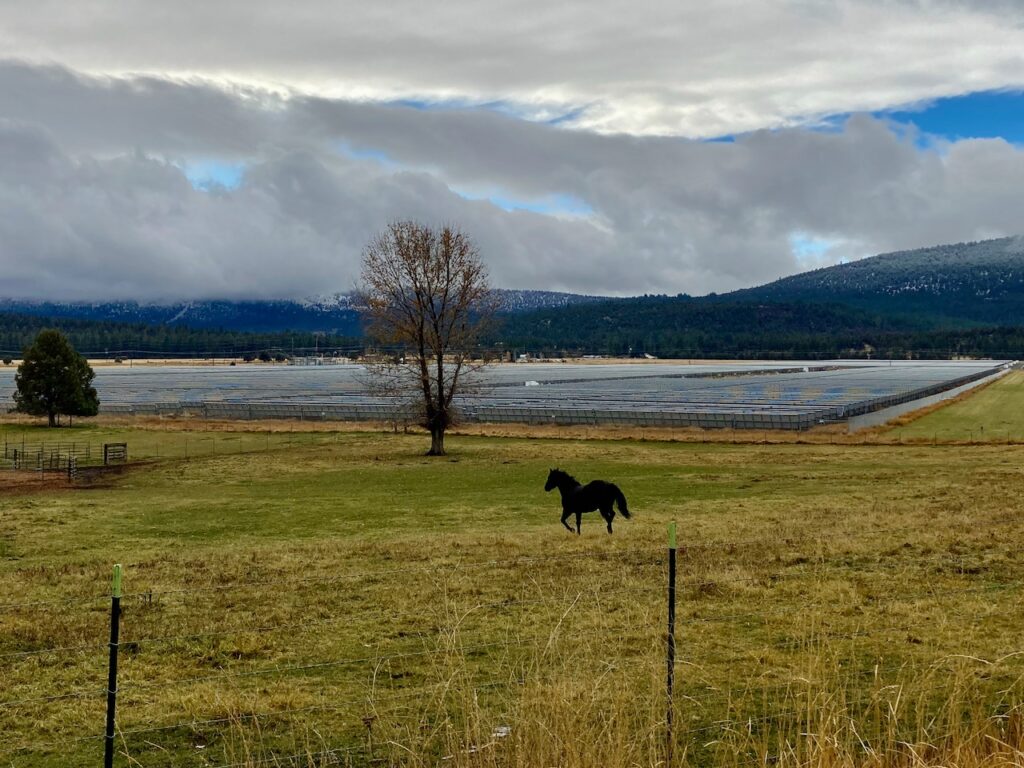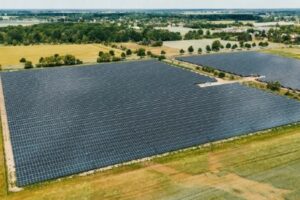Rural Oregon’s clean energy investments at risk as Republicans pass Trump’s budget bill

Three years ago, massive federal climate legislation led to a boom of solar, wind and energy storage projects across rural Oregon, reshaping its farming landscape and shoring up the state’s prospects to reach its aggressive emission reduction mandates.
But the projects’ future may be undone by a budget bill passed Thursday by U.S. House Republicans that seeks, among other cuts, to undo clean energy incentives to pay for President Donald Trump’s proposed tax breaks.
At stake are generous tax credits adopted via the 2022 Inflation Reduction Act, which led clean energy companies to announce hundreds of billions of dollars in investments throughout the U.S. – including billions in Oregon.
Most of the investments are slated for Republican-held congressional districts – and two-thirds of the projects have yet to launch or have barely broken ground, according to data from the Clean Investment Monitor, a joint project of the research firm Rhodium Group and the Massachusetts Institute of Technology.
In Oregon, according to the data, companies have announced $12 billion in solar, wind and storage investments over the past three years, with $10.8 billion in the 2nd District represented by Rep. Cliff Bentz, the only Republican in Oregon’s congressional delegation. The district is the state’s largest and deeply red, roughly covering two-thirds of Oregon east of the Willamette Valley.
So far, $9.8 million of the investments in Bentz’s district are pending, including Sunstone Solar, Oregon’s largest approved solar and storage project, planned on 10,000 acres of farmland in Morrow County.
These investments could dry up as the tax credits disappear if the House version of the bill becomes law.
Another provision in the bill would limit the ability of companies to import clean energy components from countries like China – a problem because the components aren’t yet manufactured at scale in the U.S.
Clean energy advocates say stalled or dropped projects would put Oregon’s transition to clean electricity at risk and constrain the supply of clean, reliable electricity at a time when surging demand from data centers is already putting enormous pressure on the region’s aging electric grid and maxed out transmission lines.
The bill also likely would lead to an increase in utility bills for Oregonians who already struggle with double-digit increases for both electricity and natural gas, they say.
“We’ve been really leaning on these federal incentives to accelerate clean energy projects and deploy renewables faster,” said Nora Apter, the Oregon director at Climate Solutions, a Northwest-based nonprofit that advocates for clean energy to slow global warming.
“And this bill is essentially taking a wrecking ball to all that we still stand to gain from these clean energy incentives,” Apter said. “It will raise energy costs, it will hurt jobs, it will lead to more blackouts and it’s going to pull the plug on investments that are supporting our economy and our energy independence and security.”
Bentz did not respond to multiple calls and emails for comment. He voted for the bill, which passed by the slimmest of margins 215 to 214.
Other outstanding projects in his district include the approved but not constructed Nolin Hills wind and solar energy generation facility on 48,196 acres in Umatilla County; the proposed but not yet approved Deschutes solar and battery storage project by developer BrightNight Power on 13,626 acres in Wasco County; and a 4,000-acre solar and battery storage project addition, currently under state review, to the Biglow Canyon Wind Farm that is already operating on 25,000 acres in Sherman County.
Data on which companies claim tax credits is not publicly available, but it is likely many, if not most, would apply for them.
Pine Gate Renewables, the developer behind Sunstone Solar in Morrow County, said the company expects the early phases of the project to qualify for and claim the federal investment tax credit for clean energy projects available under the Inflation Reduction Act.
“Policy certainty is a cornerstone of planning for any multi-year investment and especially one with the magnitude of Sunstone Solar,” company spokesperson Maggie Sasser said via email. “That said, we remain confident in the bipartisan support for projects like Sunstone and ultimate preservation of some form of tax credits for clean energy projects.”
The Republican bill that just passed the House adds to existing challenges with Oregon’s transmission constraints and Trump-imposed tariffs, said Nicole Hughes, executive director of Renewable Northwest, a nonprofit that advocates for building more clean energy projects to meet climate goals in Oregon, Washington, Montana and Idaho.
The threat of gutted clean energy tax credits could prevent projects from moving forward or future ones from being planned and thus upend Oregon’s clean energy progress.
“The tariffs and the IRA tax credit rollback create looming uncertainty that’s making companies think twice about whether they want to invest in new projects,” Hughes said. “If you’re a developer who was planning to invest in a project in our region and you hadn’t yet pulled the trigger on it, you’re not going to do it right now.”
Under the Inflation Reduction Act, companies building solar, wind, geothermal or battery projects could claim an investment tax credit of 30% on eligible project costs for solar, wind and storage systems or a production tax credit based on the amount of electricity generated by their projects. Developers also could qualify for additional subsidies. For many, the credits formed an important layer of their project financing.
Based on the Republican bill’s newly adopted language, developers will now be able to claim the tax credits only if they start construction within 60 days of the bill being signed into law and only if they put the clean energy project in service by the end of 2028 – a tight deadline many existing projects won’t be able to meet.
The bill also terminates by year’s end popular Inflation Reduction Act tax credits for residential rooftop solar panels, electric vehicles, heat pumps and other energy-efficient household appliances and upgrades, among others.
Tax breaks for nuclear power and carbon capture projects would remain unchanged. The bill also offers incentives and expedites natural gas and oil development.
Some see solar, wind and other clean energy projects — which are often approved on Oregon’s high-value farmland or other soils designated for growing crops — as a threat to the agricultural way of life, local farm jobs, wildlife habitat, scenic views and tourism. They say wind, solar and storage projects do not create a lot of jobs, other than temporary construction jobs, and aren’t part of local farming communities.
But other rural landowners and clean energy proponents point out the projects generate significant tax revenue for rural counties, provide supplemental income to farmers who lease their land to the projects and invest in local hospitals and schools at a time when many counties struggle to cover basic services.
“A lot of Oregon rural counties have a shrinking tax base and increasing costs,” said Jake Stephens, CEO of NewSun Energy, which has developed solar farms at four locations in Lake and Harney counties and has sponsored local scholarships and clinics. “Rural communities, landowners and local governments are major beneficiaries of the rents, jobs and property taxes from these projects.”
The huge Sunstone Solar project in Morrow County, which has yet to be built, plans millions of dollars in a per-acre payments to a new county fund for agricultural uses. Wagon Trail Solar, another recently approved project on 7,450-acre in Morrow County, has promised a similar mitigation fee approach.
U.S. Sen. Ron Wyden of Oregon, the top Democrat on the Senate Finance Committee who helped write clean electricity credits, warned Friday at a news conference in the Capitol that the rollback would be most painful outside metro areas.
“And where have we seen the most progress? We’ve seen it in rural America. We’ve seen it in communities that previously didn’t have the opportunities to get these innovative companies and jump start new approaches to create jobs.”
For now, clean energy proponents and developers are still waiting to see whether the Senate can tone down the aggressive House rollbacks.
“The Senate must push back on the phase-out timeline and provisions threatening the import of key components,” said Hughes of Renewable Northwest.
— Gosia Wozniacka covers environmental justice, climate change, the clean energy transition and other environmental issues. Reach her at gwozniacka@oregonian.com or 971-421-3154.
Our journalism needs your support. Subscribe today to OregonLive.com.





